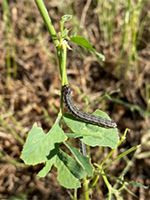
Fall armyworms Q&A
 By Augusta Witt, Vita Plus dairy specialist
By Augusta Witt, Vita Plus dairy specialistJustin Witt owns and manages Witt Ag Solutions in northwest Illinois, helping farming customers with their agronomy needs. In late September of last year, a dairy producer called and asked him to look at an alfalfa field as it appeared something was killing it off. I sat down with Witt for a Q&A session to learn more about his experience with fall armyworms and strategies to combat them.
Q: What did the affected field look like?
A: From a roadside glance, one would have thought the field was recently sprayed and killed off or that drought conditions had gotten to it. But not every alfalfa field was affected. Some neighboring fields presented themselves differently. From my observations, it seemed the difference was influenced by where the farm was in its cutting cycle between crops.
Q: What was really happening in the field?
A: The farmer’s field was being overtaken by fall armyworms. There are two types of fall armyworms. This type was the rice strain fly that migrates from Florida and the U.S. Gulf Coast, as explained in this article from Iowa State University Extension. The rice strain fly feeds on rice, alfalfa, millets, forage grasses and turf. The corn strain fly from Texas and the Mexican gulf coast target corn, sorghum and cotton. Fall armyworms cannot overwinter in the Midwest, so the first good freeze will kill them.

Q: How do you scout for fall armyworms?
A: Because they are nocturnal, the best time to scout for fall armyworms is at sunrise or sunset. It is always wise to scout for them – even if the season is nearing its end.
If fields are left untreated, it would look like an army quickly marched across the field and killed everything. If they go uncontrolled, they can travel into pasture grasses, waterways, etc.
Q: How can you control fall armyworms?
A: If it works in the cutting cycle, the first option may be to harvest the crop immediately, but many variables affect that decision. For example, how close are you to a killing frost? What are your feed inventory needs?
Often, the best course of action is use of an insecticide. Two to three fall armyworms per square foot is enough to warrant spraying a pyrethroid insecticide. Spray early because insecticides are less effective when the larvae are greater than ¾ inches long.
More established fields can handle some pressure – if they are sprayed quickly – and the field will recover the following season. However, new stands can struggle to come back the next year if there was a high pressure of feeding.
Q: How can you prevent them in future years?
A: Whether you will have any armyworm issue in future years literally depends on which way the wind blows. The dry summer we had in 2021 seemed to create favorable conditions for fall armyworms. It’s advisable to scout for armyworms each year to minimize damage to your fields.
| Category: |
Crop varieties Forage Foundations |

